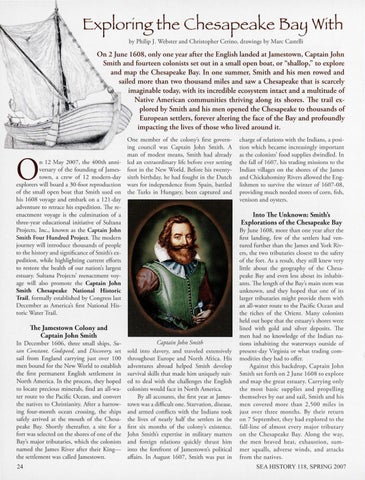E:xploringthe Chesapeake 5a!::J With by Philip J. Webster and C hristopher Cerino, drawings by Marc Castelli
On 2 June 1608, only one year after the English landed at Jamestown, Captain John Smith and fourteen colonists set out in a small open boat, or "shallop," to explore and map the Chesapeake Bay. In one summer, Smith and his men rowed and sailed more than two thousand miles and saw a Chesapeake that is scarcely imaginable today, with its incredible ecosystem intact and a multitude of Native American communities thriving along its shores. The trail explored by Smith and his men opened the Chesapeake to thousands of European settlers, forever altering the face of the Bay and profoundly impacting the lives of those who lived around it.
0
n 12 May 2007, the 400th anniversary of the founding of Jamestown, a crew of 12 modern-day explorers will board a 30-foot reproduction of the small open boat that Smith used on his 1608 voyage and embark on a 121-day adventure to retrace his expedition. The reenactment voyage is the culmination of a three-year educational initiative of Sultana Projects, Inc., known as the Captain John Smith Four Hundred Project. The modern journey will introduce thousands of people to the history and significance of Smith's expedition, while highlighting current efforts to restore the health of our nation's largest estuary. Sultana Projects' reenactment voyage will also promote the Captain John Smith Chesapeake National Historic Trail, formally established by Congress last December as America's first National Historic Water Trail.
One member of the colony's first governing co uncil was Captain John Sm ith. A man of modest means, Smith had already led an extraordinary life before ever setting foot in the New Wo rld. Before his twentysixth birthday, he had fought in the Dutch wars for independence from Spain, battled the Turks in Hungary, been captured and
Into The Unknown: Smith's Explorations of the Chesapeake Bay
The Jamestown Colony and Captain John Smith In December 1606, three small ships, Susan Constant, Godspeed, and Discovery, set sail from England carrying just over 100 men bound for the New World to establish the first permanent English settlement in North America. In the process, they hoped to locate precious minerals, find an all-water route to the Pacific Ocean, and convert the natives to Christianity. After a harrowing four-month ocean crossing, the ships safely arrived at the mouth of the Chesapeake Bay. Shortly thereafter, a site for a fort was selected o n the shores of one of the Bay's major tributaries, which the colonists named the James River after their Kingthe settlement was called Jamestown. 24
charge of relations with the Indians, a position which became increasingly important as the colonists' food supplies dwindled. In the fall of 1607, his trading missions to the Indian villages on the shores of the James and Ch ickahominy Rivers allowed the Englishmen to survive the winter of 1607-08, providing much needed stores of corn , fish, venison and oysters.
Captain John Smith sold into slavery, and traveled extensively throughout Europe and North Africa. His adventures abroad helped Smith develop survival skills that made him uniquely suited to deal with the challenges the English colonists would face in North America. By all accounts, the first year at Jamestown was a difficult one. Starvation, disease, and armed confl.icts with the Indians took the lives of nearly half the settlers in the first six months of the colony's existence. John Smith's expertise in military matters and foreign relations quickly thrust him into the forefront of Jamestown's political affairs. In August 1607, Smith was pur in
By June 1608, more than one year after the first landing, few of the settlers had ventured further than the James and York Rivers, the two tributaries closest to the safety of the fort. As a result, they still knew very little about the geography of the Chesapeake Bay and even less about its inhabitants. The length' of the Bay's main stem was unknown, and they hoped that one of its larger tributaries might provide them with an all-water route to the Pacific Ocean and the riches of the Orient. Many colonists held out hope that the estuary's shores were lined with gold and silver deposits. The men had no knowledge of the Indian nations inhabiting the waterways outside of present-day Virginia or what trading commodities they had to offer. Against this backdrop, Captain John Smith set forth o n 2 June 1608 to explore and map the great estuary. Carrying only the most basic supplies and propelling themselves by oar and sai l, Smith and his men covered more than 2,500 miles in just over three months. By their return on 7 September, they had explored to the fa ll-line of almost every major tributary on the Chesapeake Bay. Along the way, the men braved heat, exhaustion, summer squalls, adverse wi nds, and attacks from the natives. SEA HISTORY 118, SPRING 2007
